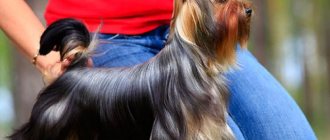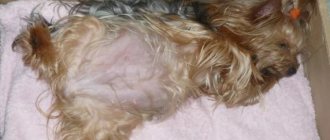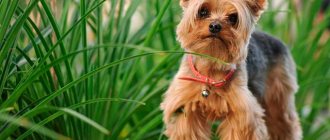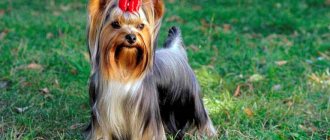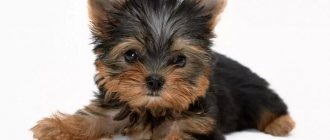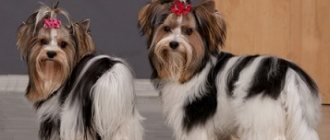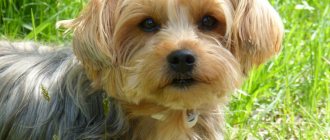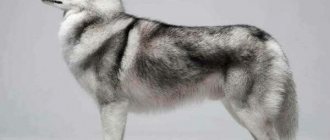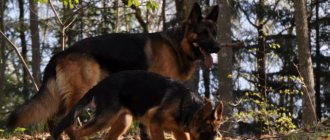Among lovers of decorative dogs, miniature Yorkies are very popular and loved. They are cheerful and friendly, and their appearance is so pretty that the dogs can easily be confused with toys. This is also facilitated by the size of the representatives of the breed - the size and weight of Yorkshire terriers are such that they are convenient not only to keep in a city apartment, but also to take with you on trips, trips, visits and to any events. Dog owners should know what the standard is for their pets to gain weight and when they reach peak physical fitness. This will help you notice your Yorkie’s lagging behind in growth and development in time and take action if necessary.
Description of the Yorkshire Terrier breed
Popularity 19th among 263 dog breeds
Lifespan:
13-15 years old
Breed group:
Decorative
Height:
15-17 cm
Country of origin:
Great Britain
Average price:
20-30 thousand rubles
Weight:
1.7-3.1 kg
Latest articles Cat health
Rabies vaccination for cats: choice of vaccine, necessity, schedule 01/22/2022 4 0 0
Selection and adaptation
TOP 20 best cat breeds for families with children 01/22/2022 25 0 0
Micro Yorkies - a rare species or breed defect
We should also talk about dwarf Yorkshire terriers, which are often called super-mini or micro-Yorks. Two more common names for this type of dog are pocket or cup dogs. These nicknames were given to the animals because of their ability to fit into a bowl or pocket.
Breeders often offer to buy micro Yorkshire terriers at high prices for profit. They justify this price tag by the fact that this is a rare species, exclusive representatives of a popular breed. Of course, you can buy a pet whose weight does not reach 1-1.5 kilograms, but you need to remember - this is a breed defect!
Keeping miniature dogs is a responsible, troublesome and time-consuming task. Micro Yorkies get sick more often, are susceptible to injury, and require special care and feeding regimen. It is necessary to ensure that animals do not jump from beds, sofas and chairs, as they can injure their heads and limbs.
Dwarfism, which is inherent in these cute miniature pets, causes nervous system disorders in dogs. Because of this, they can be more aggressive, have an unstable psyche, and are more difficult to learn and train.
Health problems, which these pets also have a lot of, lead to a sharp decrease in life expectancy. Dogs do not live to be 8-9 years old.
Frequent pathologies:
- not overgrown fontanel;
- incomplete dentition;
- eye pathologies;
- oral and dental problems;
- inability to bear and produce offspring;
- risk of increased injury.
When getting such a dog, you need to constantly monitor where it is so as not to accidentally step on it or get pinched by the door. It is dangerous to leave her alone with small children. They can cause harm to health and pose a threat to the life of a micro-dog.
All Super Mini Yorkshire Terriers must be spayed to prevent accidental pregnancy. Pregnancy for such dogs is a danger to health and life. With them you can forget about breeding, participation in competitions and an exhibition career.
Advantages and disadvantages
- Pros:
- tiny size allows you to keep Yorkies in cramped apartments and take them with you almost everywhere;
- does not cause allergies due to the special coat;
- aesthetic appearance that can be embellished to your liking;
- insightful mind and good learning ability;
- no need for walking twice a day, as you can train the dog to use the litter tray;
- friendliness and sociability of the dog.
- Minuses:
- troublesome care, especially for wool;
- high cost of purchase and maintenance;
- the need for a strict diet;
- Not very good health of dogs.
Grooming
Proper coat care is the key to a healthy dog. Yorkshire Terriers are unique due to their coat, which resembles human hair. This breed does not have an undercoat, so dogs can freeze in the cold season. You need to buy warm clothes for your baby; they can be found in specialized stores for dogs. You need to be prepared that keeping a pet costs a decent amount.
Clothing options
The dog needs to be bathed regularly, preferably once every week or two. After bathing the terrier, wrap it in a towel and dry it with a hairdryer. During walks, wool quickly gets dirty and loses its shine.
For your information! It is important to choose the right shampoo. Yorkies have sensitive skin and are often prone to allergies.
There are special lines of shampoos for long-haired dogs. You can also buy a special spray that makes it easier to comb your pet.
To maintain a shiny, tangle-free coat, your Mini Yorkie must be brushed regularly. It is better to carry out this procedure once every two days. Once every two to three months, your pet should be given vitamins; they have a beneficial effect on the health and condition of the dog’s coat. You should first consult a veterinarian, he will select the appropriate drug.
An animal on the street can pick up ticks and other parasites, so the owner needs to treat the fur with special products against these pests once a month. Veterinarians do not recommend giving mini-Yorks modern tablets that protect against parasites. It is better to use drops that are applied to the animal’s withers and spine so that the product does not get into its mouth. The instructions detail how many drops you need to apply depending on the weight of your miniature Yorkie.
Key facts
In recent years, Yorkshire Terriers have become very popular in the world, and this is not surprising. This adorable little companion dog is friendly, energetic and easy to keep even in a small apartment.
Brief characteristics of the Yorkshire Terrier breed - it is a brave, hardy and intelligent small dog, surprisingly delicate and intelligent. The male is usually larger in height and weight than the female. The height at the withers can reach 28 cm, but on average it is 17-20 cm.
York chooses a leader, whom he considers his master. He's a great friend to everyone else. York is an energetic playmate for children and a devoted and selfless companion for older people.
Small dogs live in country houses and small studio apartments. In training, the Yorkie grasps everything on the fly, but is restless.
Descriptions of the Yorkshire Terrier breed focus heavily on appearance. The beautiful fur of a Yorkie is his pride; it requires careful care, namely washing and combing. Making simple haircuts is easy for the owner himself. But it is better to entrust model haircuts or preparation for an exhibition to a professional groomer.
The Yorkie is very selective when it comes to food. Due to the breed's tendency to allergies, you should not treat your pet from the common table. It is best to feed your dog with properly selected balanced dry food.
Due to its tiny size, the Yorkie is prone to injury, so you need to be very careful about its health and active play. To purchase a purebred dog, you should contact trusted breeders. The life expectancy of a Yorkshire Terrier directly depends on care and timely treatment. With a good owner, the baby will live for 15 years, or even more.
Pet nicknames are invented by the owners, and the name in the pedigree is usually complex, consisting of several words. The name of the kennel comes at the beginning or at the end, if the kennel begins with a preposition (for example, “from the Yorkshire house”), and then the nickname itself consists of 1-2 words, and all names of the litter begin with a certain letter.
Despite its miniature size, the Yorkie has the character of a real terrier. The courage and devotion of this little one evokes genuine respect. The Yorkie is one of the most popular breeds in the world, adored for its appearance and disposition.
How old do Yorkies grow?
The period of active growth of Yorkshire Terrier puppies continues until the onset of puberty.
This means that by 8-9 months the dog reaches its maximum height and length, but continues to gain weight, although not as intensely, and to take shape - the chest area becomes a little wider, and muscle mass is gained.
It is important to understand that the age range of development is an approximate guideline.
The growth and development of the Yorkshire Terrier depends on a number of factors:
- genetics;
- health conditions;
- balanced diet;
- conditions of detention, etc.
History of the origin of the Yorkshire Terrier
The breed was developed in the British Isles. The country of origin is England, and specifically the county of Yorkshire. Its ancestors were small dogs with a hardy character and tenacious jaws - Scottish terriers. They were brought to Yorkshire by workers from Scotland who arrived to work in the mid-19th century.
It is not known exactly which of the many breeds of Scottish terriers took part in the development of the Yorkie. Presumably, one of the ancestors of the breed were Waterside Terriers, which protected peasant houses from rodents.
Interesting fact: peasants bred miniature terriers, since they were forbidden to keep large dogs in order to avoid poaching on the lands of the lords. The appearance of Yorkies has features of the Skye Terrier, Cairo Terrier, Manchester Terrier, Paisley Terrier, and they may owe their silky coat to the Maltese.
The name of the new terrier breed was coined in 1874, and the Yorkshire terrier was officially declared an independent breed in 1886 by the English Kennel Club. The breed standard, which is still relevant today, was adopted in 1898, although they began to be shown at exhibitions already in 1861 under the name “Hairy Scottish Terriers.” The heyday of the Yorkie's fame in Britain came during the reign of Queen Victoria, who adored dogs and instilled the custom of having pets among the ladies of high society.
In the USA, the American Kennel Club registered the first Yorkie in 1885, and a hundred years later in Germany, a new breed was developed from the Yorkshire terrier - the Biewer Terrier, which differed from the Yorkies in its black and white coat and was initially exhibited under the name "black and white Yorkshire terrier" .
The Yorkshire Terrier owes its appearance in Russia to the ballerina Lepeshinskaya - she received a puppy as a gift in 1971. The first Yorkie breeder registered a kennel in 1991 in Moscow's Mytishchi, and today there are more than 75 of them.
In the 21st century, the trend for Yorkshire terriers continues. They are among the ten most common breeds in the world, and in the United States, according to the American Kennel Club, Yorkies from 2006 to 2008. ranked second in popularity.
How much does a Yorkie cost in kennels abroad?
Foreign nurseries are the main source for the emergence in Russia of new promising crossbreeding lines within the breed. Usually, male puppies are imported that can be used for many matings throughout their lives. British nurseries are the most popular, since this is where the breed once appeared. Yorkies from Germany and the USA are also highly valued. Having champion parents increases the price of a puppy. The price difference between boys and girls is up to $500 .
Yorkshire Terrier abroad
This review will help you figure out how much a Yorkshire Terrier costs in rubles in foreign nurseries:
- Biewer Yorkies. A puppy with a pedigree from Germany can be brought for 282,000 rubles .
- A grown-up puppy of 6-9 months (boy) of a standard Yorkshire terrier costs from 250,000 rubles .
- A miniature boy can be bought in UK nurseries for 236-260 thousand rubles . A girl for 280-300 thousand.
- A 4 month old standard size puppy can be purchased for 216,000-388,000 . Girls are more expensive than boys in a litter.
- Biro Yorkie. Girls are valued higher; their price starts from 237,000 rubles . Boys can be purchased from 177,000 .
It is worth considering that European breeders prefer not to offer puppies for sale under 16 weeks. This allows the buyer to receive vaccinated and microchipped pets with predictable breed and size characteristics, clear prospects for breeding or an exhibition career.
Similar dog breeds
Shih Tzu
Maltese
Cavalier King Charles Spaniel
Lhasa apso
Bichon Frize
York standard according to RKF
The current RKF standard was published on November 10, 2011.
According to him, the Yorkie is a long-haired terrier with a straight, flowing coat..
The parting starts at the nose and ends at the end of the tail.
An elegant and compact dog with a proud and important posture:
- Head. The skull is small and flat, there are no convex parts, the transition to the muzzle from the forehead is clearly pronounced.
- The muzzle is short, the nose is small, the lobe is pigmented black.
- The jaws are straight, the row of teeth is not disturbed. The teeth are small, white, set straight. There is no gap when closing the jaws; there is a scissor bite.
- The eyes are medium-sized, round or almond-shaped, not protruding. The iris is brown, as dark as possible, with a black edging on the eyelids.
- The ears are small, triangular, erect, covered with hair.
- The neck is moderately long, slightly arched, with well-developed muscles and a pronounced nape contour.
- The body is not too long, compact, square in format. The withers are weakly expressed, the chest is oval, the shoulders are strong. The back is short, strong and straight. The belly is tucked up, the croup is rounded with a slope towards the base of the tail.
- The tail is not docked, set high, carried slightly above the level of the back, and covered with dark hair.
- Limbs. The paws are strong, even, with well-developed knee and hock joints located at right angles. The paws are collected, rounded, the claws are black, convex, slightly curved.
Appearance of the Yorkshire Terrier
General impression
Long-haired, compact and agile dog, with evenly falling hair, parted from nose to tail. The body is strong and proportional. In the photo of the Yorkshire Terrier, the assertive and open character of the dog is immediately noticeable.
Head
The Yorkie's eyes are shiny, non-protruding, straight-set. Eye color – dark brown, with dark eyelids, expression – intelligent. Small vertical ears are not very far apart and are covered with intense red short hair. Scissor bite, with vertical, close-fitting canines.
Neck
Quite long, with flowing hair and even parting.
Torso
Compact, almost square, with a flat, strong back and a clearly defined loin.
Forelegs
With pronounced shoulders, straight elbows, evenly covered with golden hair. Red-brown color is allowed up to the knee joint.
Hind limbs
Straight in front, in profile the knees are moderately pronounced, the coat is long, with a lighter tone at the ends. The red-brown color, as on the front legs, should not extend above the knee. With round paws and black claws.
Tail
The tail is usually docked in the middle, or may not be docked. The dog carries it just above the line of the back. The fur on the tail is darker the closer to the end it is.
Movement
Free with a good pace, limbs do not twist, the step is even. The dog gives the impression of a nimble and swift animal bred for hunting.
Wool
The hair on the body is straight, thin, silky, without wave. The hair on the head and ears is long. The Yorkie has no undercoat and does not shed, because the hair, like human hair, grows from one bulb.
Color
Puppies' coat is usually black and brown. With growth, the black color degenerates into a steel-blue color, and the brown color becomes lighter. By the age of 1.5 years, the Yorkie takes on its usual color. Steel blue wool should be free of impurities. It is located on the back. The fur is reddish-brown in color, darker at the roots and lighter towards the tips. Occasionally, red-legged Yorkshire terriers are born - this happens when the puppy's coat does not become bluish-brown with age, but remains black-reddish. This is called "return". All of the listed Yorkshire Terrier colors are recognized by international standards.
Size
The height of a Yorkie is not stipulated by the standard; the main thing is proportions. But the weight is clearly indicated by the standard - up to 3.1 kg, but for breeding dogs weighing from 1.7 to 2.8 are preferred.
Head
The Yorkshire Terrier's skull is small and flat, the muzzle is not long - a third of the length of the head. The neck is quite long.
The bite is scissor-shaped, even, like a dog's jaw. The teeth are set vertically.
The eyes are medium in size, shiny, and beady. The eyelids are dark, the nose is black.
The ears are bright brick color, very small, in the shape of a “V”, located high on the head, but not very wide, so they do not seem protruding.
York baby face
The variety with a short muzzle and large eyes, the baby face (from the English “baby face”), is breaking all records of demand among Yorkshire terriers.
This York goes beyond the standard:
- round skull, very short muzzle;
- huge, even bulging eyes, with an expression of surprise;
- ears are set low.
Unfortunately, “baby faces” are characterized by chronic conjunctivitis (hair irritates overly large eyes/tear duct narrows) and breathing problems (due to a too short muzzle, the dog grunts when moving and/or snores in its sleep).
Personality of the Yorkshire Terrier
Who is the Yorkie suitable for? The Yorkshire Terrier has a very friendly personality and gets along well with other animals and children. Miniature dogs are very attached to their owner, at home they enthusiastically protect the owner’s property, and on the street both the puppy and the adult dog vigilantly watch their leader and are very worried if they suddenly lose sight of him.
In winter, the Yorkie often freezes outside, so he walks in warm overalls, or goes to the toilet at home. York Terriers are very brave and curious dogs, real little hunters.
Why is this done?
Attempts at crossing are usually called designer breeding of dogs - with a competent approach and knowledge of the basic laws, you can get quite interesting results. The results of the mixture are not suitable for exhibitions, but they have a rather interesting exterior, which contains features of both varieties. In addition, the character of a mixed breed from a Yorkie and, for example, a toy terrier, also combines the characteristics of both parents
It is important to follow one of two rules:
- Crossing two purebred individuals;
- A union of two identical design crosses.
https://www.youtube.com/watch?v=vuNSs0Jh9yg
Crossing of different breeds is done to breed new designer breeds. As mentioned above, the main goal of designer breeding is the exterior of the future dog - a Yorkie and a toy terrier or Spitz give a very interesting amount of external data.
Most dog breeders are quite skeptical about breed crossings.
Education and training
Yorkshire terriers are smart, their training does not pose any problems, but they need to be trained from early childhood. Socialization of the pet plays a big role. Some owners don’t know how to raise him, are afraid to introduce him to other dogs and don’t let him get away with it. Such puppies subsequently grow into cowardly, hysterical dogs, frightened by every rustle. Gradually, it is necessary to expand the puppy’s horizons and geography of walks, introducing him to strangers and dogs, walking in unfamiliar places. If you gradually socialize your pet, he will grow up to be a balanced, well-mannered dog.
With teaching commands, the situation is somewhat more complicated due to the stubbornness and restlessness of the Yorkie. How to start raising and training a Yorkshire Terrier? You can contact an instructor or do it yourself. Yorkies willingly perform exercises, but training should be short, with mandatory rewards in the form of praise and treats, and then there will be no problems with learning commands.
How to stop a dog from being a bully? If you catch your Yorkie in the act of a crime - the puppy is chewing on a slipper, digging up a rose bush or tearing off the wallpaper - punish him immediately. If you decide to scold him a couple of hours after the hooliganism, the baby will not understand why you are unhappy with him. Be strict, but never resort to cruelty.
Yorkies love routine, so walking and feeding should be carried out according to a schedule. In terms of toileting, dogs are easy to train to a tray or diaper, which is very convenient for people who have difficulty walking their dog due to health or a busy work schedule.
Yorkshire Terriers often become anxious at the sight of moving objects, such as cars and bicycles. How to stop them from being nervous in noisy traffic? Only by immersion in such an environment. To do this, you need to visit crowded places with your puppy during walks. If your Yorkie is not taught to travel in a car or other vehicle from an early age, there is a chance that he will get motion sickness. This will cause inconvenience to both the owner and the dog himself.
Looking for a Yorkshire Terrier? Find your pet from 1 offer As a gift
Other criteria
Activity
The Yorkie is more active, as it is a real, albeit small, terrier.
Chihuahuas are less active: these dogs prefer quiet games and resting on a bed.
Trusting strangers
Yorkies do not experience aggression towards strangers, but Chihuahuas do not like strangers: they can even attack a guest who comes to the house if they don’t like him in some way.
Health
Due to their more fragile build, Chihuahuas are more likely to suffer injuries, including fractures. They also have breathing problems, eye diseases and cardiovascular diseases. In many Chihuahuas, the fontanel on the head does not heal until the end of its life, which is why it is especially necessary to protect the dog from head injuries.
Yorkies have a predisposition to ear diseases, diseases of the digestive system and accelerated weight gain.
CAREFULLY! Both of these breeds are prone to diseases such as oral diseases, abnormal dental growth, and musculoskeletal diseases.
Hydrocephalus occurs in both Yorkies and Chihuahuas, but the latter is much more common.
Domination
The Yorkshire is a more sociable and less dominant breed.
The Chihuahua has an innate predisposition to dominance, and often there is a serious struggle between him and the owner as the pet grows up for the place of leader in the family.
Learning ability
Both breeds are distinguished by their intelligence and intelligence, but it is still easier to train a Yorkshire, since this dog, with proper upbringing, grows up balanced and calm, and its love and desire to please its owner simplify the learning process.
You need to look for a special approach to Chihuahuas, since these dogs do not tolerate people raising their voices at them: this makes them confused, and sometimes they can even fall into a state of stress.
Yorkshire Terrier Health and Diseases
The life expectancy of Yorkies is 12-15 years. What are the most common diseases a small terrier can encounter during his life?
- hypoglycemia (low blood sugar);
- neurodermatitis (neurogenic-allergic skin disease that becomes chronic);
- cancer;
- injuries.
Small puppies are predisposed to hypoglycemia - a sharp drop in blood sugar. This is a very serious problem and the dog can go into a coma. Symptoms of hypoglycemia are drowsiness, weakness, convulsions, and a sharp drop in temperature. If you see at least one of these symptoms, you should immediately go to the veterinarian, after rubbing the dog’s gums with syrup or honey. By 4 months, puppies outgrow this threat; hypoglycemia is uncommon in adult dogs.
Cancer is common among Yorkies. According to research, it most often affects females over 10 years of age. To reduce the risk of cancer and give your dog a couple of years of life, it is better for her to have sterilization at 6-7 years old if she is being bred, and around the year if pregnancy, gestation and childbirth are not planned. Bitches come into heat once every 6-12 months.
Due to their size, Yorkshire Terriers have fragile bones. To avoid joint injuries, you should not allow your dog to jump from heights or exercise in uncomfortable and potentially dangerous places. In the apartment, you should take care of the correct arrangement of furniture and the removal of unstable, heavy objects.
Yorkies are susceptible to allergies and stress. The apogee of these conditions is neurodermatitis, which has a very negative effect on the coat. The first remedy in the treatment of neurodermatitis is a change in the environment and regime of the dog. In severe cases, doctors prescribe melatonin.
Yorkshire Terriers are temperature sensitive. In hot weather they easily overheat, and in cold weather they often freeze. In muddy and bad weather, it is better to pack the dog in waterproof overalls to make grooming easier.
Mini Yorkies (weighing 1.7 kg or less) are sicker than their standard counterparts. Their life expectancy is also shorter, only 7-9 years. Micro specimens weighing less than a carton of milk have an even shorter lifespan, 3-4 years. Yorkies are not prone to obesity, but if this happens, the dog will have to be put on a diet or low-calorie food and increase the amount of physical activity.
Weight and height of a Yorkie as an adult
It is quite difficult to determine exactly what the future weight of a Yorkshire Terrier will be. Immediately after birth, it is impossible to distinguish between mini and standard puppies. Before buying a Yorshik, you should check the parameters of its parents. If possible, find out what representatives of other generations were like. But this information does not guarantee that the grown Yorkie will correspond to the norm. The weight of the breed is specified in the standard; the dimensions in centimeters of an adult dog are not regulated. To be sure that the dog is developing correctly and meets generally accepted standards, they are guided by approximate data:
| Dog age | Mini | Standard | ||
| Weight (g) | Height (cm) | Weight (g) | Height (cm) | |
| 1 year | 1820-2150 | 18,0-19,0 | 2930-3150 | 22,0-25,0 |
| 2 years | 1840-2200 | 18,1-19,2 | 2935-3155 | 22,2-25,2 |
| 4 years | 1845-2210 | 18,5-19,4 | 2930-3200 | 22,5-25,5 |
| 6 years | 1830-2200 | 186-194 | 2940-3210 | 22,8-25,6 |
| 8 years | 1820-2110 | 18,6-19,4 | 2940-3150 | 23,0-25,4 |
| 10 years | 1800-2180 | 18,5-18,9 | 2900-3100 | 22,8-25,0 |
| 12 years | 1810-2150 | 18,6-18,7 | 2950-3050 | 23,0-25,0 |
The maximum weight of a mini Yorkshire terrier is 2.2 kg, the standard reaches 3.2 kg, height at the withers is no more than 25 centimeters.
Features of feeding and diet
The most pressing questions that arise immediately when purchasing a puppy are what to feed and how to feed it.
An adult Yorkie usually has 2-3 feedings per day. Don't worry if there is food left in the bowl - the dogs themselves know how much to eat. Your veterinarian can tell you what food to feed, but it is better to choose high-class dry industrial food. You can also feed homemade food, but calculating the norms is quite difficult. Under no circumstances should you treat your Yorkie to fried and fatty foods, smoked meats, and sweets.
If you want to switch your dog from one food to another, it is better to do it gradually, replacing part of the portion with a new food, otherwise your picky Yorkie may refuse food altogether. The number of treats per day should also be limited.
How to determine?
To determine whether it is a baby face or a standard Yorkie, you should take two measurements of the head: from the tip of the nose to the back of the head and the length of the muzzle, and then compare them. If it turns out that the length of the muzzle is 1:3 or less of the total length of the head, then it is indeed a baby face. And for the standard this ratio will be approximately 1:2.
Maintenance and care
When you take a puppy into your home, ask the breeder for some item from the mother's house - a diaper, a toy, a scrap. It will be easier for a baby separated from his mother and brothers to bear the separation if there is an object with the smell of home nearby.
Immediately you need to put the bowls and toilet in a permanent place. You need to put a sunbed in a warm place in the room. It is better not to take a puppy into your bed, no matter how pitifully he whines for several reasons:
- he will get used to sleeping with you, and it will be difficult to kick him out of bed in a week;
- the puppy is small, and you can easily injure him in a dream;
- he has not yet learned where the toilet is in the new house, and can use your bed as it;
- your bed is too high for your puppy; if he decides to jump off, he could break or dislocate his leg.
The puppy needs to be vaccinated.
The first vaccinations are done at the breeder. Before each vaccination, deworming is necessary - prevention against worms. The last rabies vaccination is given, and after it you can start walking with your pet. The first walks are best taken for 10-15 minutes, gradually increasing to 30-60 minutes. An adult Yorkie should be walked 2-3 times a day. Yorkies need to have their nails trimmed, ears and teeth cleaned regularly. Not all dogs like these procedures, so the owner must be persistent. If you cannot overcome the dog’s resistance, you can go to grooming salons, where haircuts are also done. Perhaps this is the most difficult part of caring for and maintaining a Yorkshire Terrier; otherwise, he is unpretentious.
Claws are trimmed once every 2-3 months as they grow. It is good to cut them after bathing, when they are softened. You cannot cut the claw at the root, as there are vessels nearby. Ears are cleaned as they become dirty. The oral cavity requires special attention. Yorkies' teeth are a weak point; without care, by the age of three they become loose, and a 5-7 year old dog may turn out to be completely toothless. This negatively affects the dog’s life and the functioning of the digestive tract. Therefore, teach yourself and your puppy to perform oral hygiene regularly, using special products from a veterinary pharmacy.
The fur of the Yorkshire Terrier is a special matter. If your Yorkie is long-haired, you need to bathe it weekly; short-haired ones can be bathed a couple of times a month. Brushing should be done at least once a day - this will help prevent the fur from becoming tangled.
Washing is carried out at a temperature several degrees colder than body temperature (in dogs it is about 38.5 degrees). In the bath, you need to make sure that the dog does not slip and that water does not pour into his ears. Pet stores sell special shampoos for Yorkie fur - it is better to use them to avoid allergies. After washing, you need to dry the dog with a towel and comb it. For hygiene purposes, you can trim the hair on the ears, around the paw pads and butt.
Initial recommendations
Before raising a Yorkshire Terrier, it is worth familiarizing yourself with the basic principles of training. Below are some tips on how to train these dogs:
Advertising:
- To begin with, make sure that you purchase your Yorkie from a reputable cattery. A dog's character traits are often not only the result of upbringing, but also a consequence of genetic baggage. Good breeders will weed out those with unstable temperaments, so you have a much better chance of success if you want a pet from parents with the right temperament.
- Raising a Yorkshire Terrier always begins with the distribution of roles - from the moment he appears in your home, let him clearly understand that you are the leader of the pack, he is a subordinate. First, give him a place - a bedding, rug or box where the puppy will live. Bring him there, put him down, play with him and treat him to something tasty. The moment you put him there, say the command “Place!” Repeat this regularly to the student until he understands the information enough to go there at your request. This will be a good rehearsal before teaching your Yorkie commands.
It's best to start training with the simplest commands.
- When starting to train a Yorkie puppy at home, accustom him to a stable daily routine - food, walks and rest should be at the same time.
- Always feed your pet after you have eaten yourself - this will strengthen your position as the leader of the pack.
- Remember that only the leader always occupies the highest position - so do not allow the puppy to jump on chairs, chairs and other furniture. In addition, he may fall from an elevated position and injure himself. Anything above the puppy's eye level is considered elevated.
- Do not allow your pupil to walk ahead of you along the corridor or climb the steps, or to be the first to enter the door - only the leader is allowed to do this. You decide where the pack goes and, accordingly, go ahead. As for the steps, the same factor plays a role here as when jumping. The dog is above you and watches you rise - your status in his eyes automatically becomes lower.
You must show yourself as a master in the eyes of your pet.
Raising a Yorkie at home is based on the fact that the decision is always yours. This applies even to such little things as affection or games - if a dog pokes its nose into your hand, begging for affection, this is not a reason to succumb to its manipulation. Don't forget - you are the leader and you decide when to pet your pet. Yorkshires often understand gestures much better than voice commands - try to take this into account
Also, be careful that your gestures do not contradict your verbal orders, otherwise you risk confusing your dog.
Tips for choosing a puppy
If you want to buy a healthy and beautiful Yorkie, you need to find a good nursery that engages in breeding. A good breeder will give advice on all issues, and will also take an interest in your living conditions: he does not care which home the puppy ends up in. There is a queue for a good breeder, and he is looking for the best hands for his baby.
The owner of the kennel must show you the mother and a photo of the father, or vice versa if the puppy is alimony.
The puppies already have puppy cards, a kennel mark (a tattoo of numbers and letters on the stomach or ear), and a veterinary passport with partially completed vaccinations, and their parents have RKF-FCI pedigrees or, in extreme cases, SKOR. If you plan to participate in exhibitions, it is better to take a puppy from the RKF kennel.
If you don’t know how to choose a puppy, ask the breeder to advise you. He will help you make a choice in accordance with your ambitions (whether you want to go to exhibitions or just need a companion). Yorkshire Terrier puppies from the same litter can vary greatly in price depending on what class each baby belongs to - pet, breed or show.
You should not look for puppies on free message boards - there are a lot of scammers and outbids who post other people's photos, sell puppies with fake documents, and it is not even a fact that these are Yorkshire terriers. Sometimes they are underfed in order to be sold at a higher price as Mini Yorkies. How can you spot a scammer?
- The puppies may have documents from federations registered in Moscow at Krasnobogatyrskaya, 2.
- The cost will be slightly lower than for puppies in trusted nurseries.
- The reseller will never show you the puppy's mother.
- He has many puppies of different breeds (more than five).
- The puppies themselves look unhealthy and are in poor conditions.
- Resellers answer your questions briefly and reluctantly.
It’s also not worth buying an animal from them because the puppies are often sick. Having saved on the purchase, you will then pay a large amount for the treatment of the dog, and it’s good if it stays alive.
Prices for mini, beaver and choco-yorkies in Russia
Prices for Mini, Biewer and Shoko-Yorks
Non-standard, but very decorative varieties of Yorkshire terriers today are much more popular than their standard counterparts. When figuring out how much a mini, beaver or choco Yorkshire terrier costs, it is worth considering the difference in prices for them. Show-class Biewer puppies are considered the most expensive in Russia today.
This review will help you get a more detailed idea of the cost of dogs in each category:
- Mini. Boys and girls are sold at prices starting from 25,000 rubles for a puppy with a pedigree and from 15,000 for a pet without exhibition prospects.
- Beaver. The most expensive variety of Yorkshire Terriers. A puppy with a good pedigree can be purchased for 175,000 rubles or more.
- Biro. A boy can be purchased for 20,000 rubles , already with a veterinary passport and vaccinations. Girls cost about 30,000 rubles .
- Shoko. Boys are sold at an average price of 20,000 to 45,000 rubles .
- Baby face. Usually puppies with a charming “baby” face are mini sizes. The difference in price may be insignificant, usually starting from 25,000 rubles .
It is important to remember that the charming Choco-Yorks and Biros are not recognized breed groups by the RKF and FCI. These dogs are sold without a pedigree. It will not be possible to participate in exhibitions with them. Beavers are recognized at the national level by many European federations and the RKF. But in official documents the York prefix will be absent .
How much does a Yorkshire Terrier cost?
The price of a Yorkshire terrier with all documents depends on the region, but the average cost is from 20,000 to 60,000 rubles. For puppies of titled parents, the seller can ask more than 100,000 rubles.
You should not buy a puppy without a pedigree, because the metric is not a piece of paper for exhibitions, but a guarantee that you will grow up a Yorkshire terrier with the correct exterior and character, as you imagine it from photographs and pictures on the Internet. If you want to buy a Yorkshire terrier inexpensively and are not going to make a champion out of your pet, it’s better to look in different nurseries; there are puppies with defective exteriors, for example, in color or bite, which will be given to you at the price of dubious dogs without a pedigree.
Do you like the article? 0
What does the price depend on?
First of all, the puppy's value will be determined by the cost of raising it (including its mother) before sale. If they lived in ideal conditions and received excellent nutrition, the higher the price will be. Also, the cost will be inversely proportional to the age of the terrier - the older the dog, the cheaper it will be to purchase. In licensed nurseries, when purchasing a four-legged friend, the price includes the preparation of all documents in advance, including those confirming the baby’s pedigree.
Color variations
The breed standard provides only 1 color option for Yorkshire Terriers:
- the coat from the back of the head to the base of the tail is steel-gray in color, the presence of hairs of red, bronze or any other color is not acceptable;
- the paws from the ground to the elbows and knees and the chest are covered with bright and rich hair of a brown-golden color, darker at the roots;
- the hair on the head is of a golden-brown hue, most saturated on the sides, near the ears and on the muzzle;
- The ears are covered with red-yellow-brown fur.
Any other color option is considered non-standard.
The most common among them are:
- black and gold;
- golden blue;
- blue and tan.
Yorkie puppies at birth have black fur with small spots of red tan; it is not known in advance what color the coat of an adult dog will be .
Nutritional Features
The diet of Yorkshire terriers can consist of both natural products and ready-made industrial food.
It is important to decide on the type of feeding from the very beginning and not mix both diets.
If the choice fell on natural products, then the pet’s menu should contain:
- lean meat;
- offal;
- cereals;
- lean sea fish;
- vegetables and herbs;
- fermented milk products, cottage cheese.
Yorkies are not allowed:
- beans and corn;
- pasta and bakery products;
- fat meat;
- freshwater fish;
- mushrooms;
- sweets, smoked foods, pickles, marinades;
- bones;
- grapes and raisins;
- onion;
- milk;
- cabbage, turnips, potatoes;
- citruses;
- nuts.
A natural type of nutrition requires the mandatory use of an additional vitamin and mineral complex.
Having chosen ready-made industrial feed, you cannot purchase those that belong to the economy class. Suitable foods are premium, super premium or holistic, containing at least 25% and 70% meat, respectively.
The best feed brands:
- Acana;
- Royal Canin;
- Pro Plan;
- Bozita;
- Mera Dog
- Monge;
- Orijen.
The dog should always have clean water freely available, especially when feeding dry food.
Preparing for the arrival of a Yorkshire puppy
How many months can you adopt a Yorshik? Veterinarians believe that the appropriate age for the baby is 3.5-4 months. At 2 or 3 months old, Yorkshire Terrier puppies are still too small and fragile, so they will require constant supervision and special care. Not every owner has enough time and experience for this.
Before the puppy crosses the threshold of the owner’s house, several measures must be taken to make his stay in the new place safe and comfortable:
- it is necessary to remove all sharp and small objects, hide shoes, place protection on wires and sockets;
- create a limited area for play and recreation for little Yorkshire. You can allocate a part of the room for this, you can buy a special playpen for puppies. You need to put more toys there, equip a sleeping area and a toilet area. It is better to take a soft closed house as a sleeping place, because the baby, at the level of instincts, will want to hide in a “shelter”;
- You need to buy the right food for your puppy. You need to find out from the breeders or the shelter where the baby was taken from and what specific food he was introduced to.
